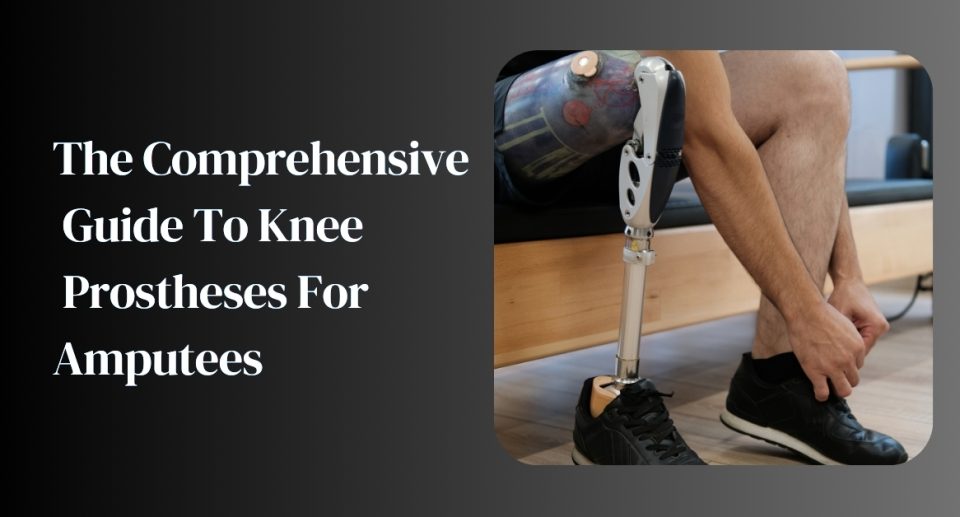Knee amputations can deeply affect a person’s life, impacting mobility, independence, and overall quality of life. However, advancements in prosthetic technology have significantly improved the functionality and comfort of knee prostheses. This guide provides a thorough overview of knee prostheses, covering their definition, types, acquisition process, maintenance tips, and more.
Table of Contents
ToggleWhat Is a Knee Prosthesis?
A knee prosthesis is a mechanical device designed to replace a lost or non-functional knee joint due to amputation or severe injury. Its purpose is to restore as much of the natural knee function as possible, allowing the user to walk, run, and engage in various activities with greater ease. Modern knee prostheses are advanced devices that use cutting-edge materials and technology to enhance performance and comfort.
Types of Knee Prostheses
1. Single-Axis Knee Prostheses
Single-axis knee prostheses are the most basic type, featuring a simple hinge mechanism that allows the knee to bend and extend in one plane. These prostheses are typically lighter and easier to control but may offer limited stability and flexibility. They are ideal for individuals with low activity levels or those seeking a straightforward solution.
2. Polycentric Knee Prostheses
Polycentric knee prostheses have a more complex design with multiple pivot points, enabling more natural movement. This type closely mimics the biomechanics of a natural knee joint, providing better stability and a smoother gait. Polycentric knee prostheses are suitable for more active individuals who need higher functionality.
3. Hydraulic and Pneumatic Knee Prostheses
Hydraulic and pneumatic knee prostheses utilize fluid-based mechanisms to control knee movement. Hydraulic prostheses use fluid to dampen movement, while pneumatic prostheses use air pressure. Both types offer adjustable resistance and can adapt to various walking speeds and terrains, making them ideal for active lifestyles.
4. Microprocessor-Controlled Knee Prostheses
Microprocessor-controlled knee prostheses are among the most advanced options available. They use sensors and computer algorithms to continuously adjust knee movement based on real-time data, offering superior gait control, balance, and adaptability. These prostheses are highly recommended for individuals requiring a high degree of functionality and customization.
Tips for Maintaining Your Knee Prosthesis
Maintaining your knee prosthesis is crucial for its longevity, functionality, and your comfort. Here are some essential tips:
1. Regular Cleaning
- Daily Cleaning: Clean the socket and outer parts of the prosthesis daily with mild soap and water. Avoid harsh chemicals that can damage the materials.
- Dry Thoroughly: Ensure all parts are completely dry before reattaching the prosthesis to prevent skin irritation or mold growth.
2.Inspect for Damage
- Visual Checks: Regularly inspect the prosthesis for signs of wear, such as cracks, loose components, or fraying straps.
- Functional Testing: Test the knee joint’s movement and alignment to ensure it functions correctly and does not cause discomfort.
3. Proper Storage
- Avoid Extreme Temperatures: Store your prosthesis in a cool, dry place, away from direct sunlight and extreme temperatures that can degrade the materials.
- Use Protective Covers: When not in use, cover your prosthesis to protect it from dust and accidental damage.
4. Check for Proper Fit
- Adjustments: Ensure the prosthesis fits snugly but comfortably. If you experience discomfort or changes in fit, consult your prosthetist for adjustments.
- Alignment: Verify that the knee joint alignment is correct to avoid gait and stability issues.
5. Skin Care
- Inspect Your Skin: Regularly check your residual limb for signs of irritation, redness, or sores. Proper skin care helps prevent complications and ensures a better fit.
- Moisturize: Use appropriate moisturizers to keep your skin healthy and prevent dryness, which can affect the fit of the prosthesis.
The Process of Obtaining a Knee Prosthesis
1. Initial Consultation
The process begins with an initial consultation with a prosthetist or orthopedic specialist. During this meeting, your medical history, current health condition, and specific needs will be assessed. The professional will discuss various knee prosthesis types and help you choose the most suitable option based on your lifestyle and activity level.
2. Fitting and Measurement
Once the prosthesis type is selected, precise measurements and fittings are performed. This involves taking detailed measurements of your residual limb and creating a custom mold for a proper fit. Ensuring a well-fitting prosthesis is crucial for both comfort and functionality.
3. Prosthesis Fabrication
After the fitting, the prosthesis is fabricated based on the measurements and mold. This process includes constructing the prosthetic limb, knee joint, socket, and additional components. The fabrication stage may take several weeks, depending on the complexity of the prosthesis and material availability.
4. Trial and Adjustment
A trial fitting is conducted once the prosthesis is ready to ensure it meets your needs and provides the desired comfort and functionality. Adjustments may be necessary to fine-tune the fit and alignment. This stage might involve multiple visits to the prosthetist for optimal results.
5. Rehabilitation and Training
Following the fitting and adjustment, a rehabilitation program is typically recommended. This program will help you adapt to the new device, with physical therapy and training focusing on strengthening the residual limb, improving balance, and learning to walk effectively with the prosthesis.
Conclusion
Knee prostheses are vital for the rehabilitation and daily functioning of individuals who have undergone leg amputations. By familiarizing themselves with the various types of knee prostheses, understanding the acquisition process, and recognizing the importance of proper maintenance, individuals can make well-informed choices that significantly enhance their quality of life. These devices are designed to mimic the natural movement of the knee, providing stability and flexibility, which are essential for walking, running, and other physical activities.
Collaborating with a leading prosthetic knee joints manufacturer in India offers access to advanced technology and tailored solutions. These manufacturers use cutting-edge materials and innovative designs to create prostheses that are both durable and comfortable. Investing in a high-quality knee prosthesis not only boosts mobility but also enriches overall life satisfaction and activity levels. The right prosthetic can help individuals regain their independence, participate in social activities, and pursue hobbies and sports, leading to a more fulfilling and active life.




